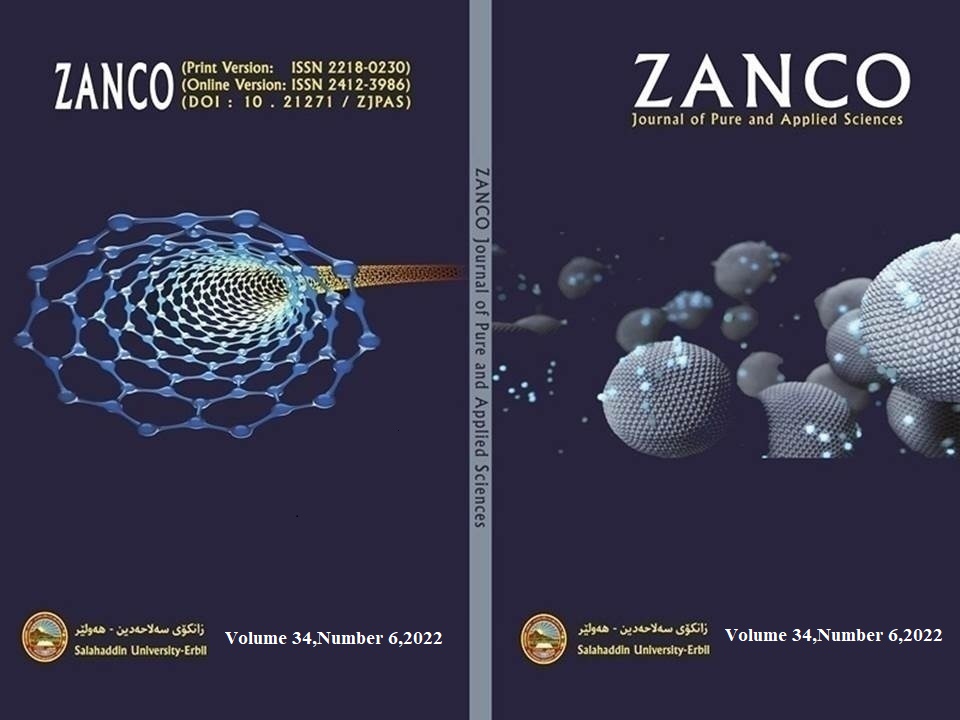The combined Application of Iron and Phosphate Solubilizing Bacteria to enhance Wheat (Triticum aestivum L.) growth and yield
DOI:
https://doi.org/10.21271/ZJPAS.34.6.13Keywords:
Wheat, Biofertilizer, Ps.Putida, P. fluorescense , B. megatrium.Abstract
This study had the objective of evaluating the efficiency of prepared iron and phosphate biofertilizers in improving wheat growth and yield. To isolate bacteria that dissolve iron and phosphate, different soil samples were collected from the Erbil governorate, a total of eighteen iron solubilizing bacteria were selected on a modified agar medium and all isolates belonged to Pseudomonas fluorescence. Twenty-two isolates of phosphate solubilizing bacteria were recognized and referred to P. putida, P.fluorescens, and Bacillus megaterium using microscopical, cultural, physiological and molecular tests. According to iron and phosphate solubilizing efficiency test, the most efficient isolate of iron solubilizing bacteria (Pfl3) and P-solubilizin bacteria (Ppu2, Bm14) were selected for biofertilizers preparation Local and imported iron and phosphate biofertilizers were applied in pot experiment. Most biofertilizers were significantly increased yield components of wheat plants. Maximum shoot length, root length, tillers number,1000 seed weight, spike number and yield (99.60cm, 58.95cm, 22, 38.75g. 20, 5.52 ton/ha respectively) were recorded by incoculation with P. Flourence + P. putida +B. megatrium significantly higher than uninoculated control and treatments with imported biofertilizer. It can be concluded that local iron and phosphate solubilizing bacterial isolates can be used for Fe and P biofertilizers.
References
ALI, N. AND T. KHANDAN (2013) Response of wheat to mineral nitrogen fertilizer and biofertilizer (Azotobacter sp. And Azospirillum sp.) inoculation under different levels of weed interference. Ekologija, 59(2): 85-94.
ANDERSON M.R.P. AND PASCUAL V.C. 2000, Microbiología Alimentaria: Metodología Analítica
BAI, Y., ZHOU, X. & SMITH, D. L. 2003. Enhanced soybean plant growth resulting from coinoculation of Bacillus strains with Bradyrhizobium japonicum. Crop science, 43(5),1774-1781.
Bakhshandeh, E., Pirdashti, H., Lendeh, K.S. 2017. Phosphate and potassium-solubilizing bacteria effect on the growth of rice. Ecol. Eng. 103, 164-169.
BAREA, J. M., POZO, M. J., AZCON, R. & AZCON-AGUILAR, C. 2005. Microbial co-operation in the rhizosphere. Journal of experimental botany, 56(417),1761-1778.
Berraquero, F. R.; Baya, A. M.; Cormenzana, A. R. Establecimiento de indices para el estudio de la solubilizacion de fosfatos por bacterias del suelo. Ars Pharmacéutica, v. 17(, n. 4):, p. 399-406, 1976.
BHARATHI, R., VIVEKANANTHAN, R., HARISH, S., RAMANATHAN, A. & SAMIYAPPAN, R. 2004. Rhizobacteria-based bio-formulations for the management of fruit rot infection in chillies. Crop Protection, 23(9),835-843.
CARLIER E., ROVERA M., JAUME A.R. AND ROSAS S. B. 2008. Improvement of growth, under field conditions, of wheat inoculated with Pseudomonas chlororaphis subsp. auarntiaca SR1. World. J. Microbial. Biotechnol., 24:2653- 2658.
CASANOVA, E.; VALEDS, A. E.; FERNANDEZ, A.E.; MOYSSET, L. AND TRILLAS, M.L. (2004) Level and immunelocalization of endogenous cytokines in thidiazuron-induced shoot organogenesis in carnation. J. Plant physiol., 161: 95-104
Chaiharn M. and Lumyong S, 2011. Screening and Optimization of Indole-3-Acetic Acid Production and Phosphate Solubilization from Rhizobacteria Aimed at Improving Plant Growth
CHAUHAN DS, SHARMA RK, TRIPATHI SC, KHARUB AS, CHHOKAR RS. News paradigm in tillage technology for wheat production. Research Bulletin No. 8, DWR, Karnal, 2011, 16.
DELVES, B., P. BLACK-BURN, R.J. EVANS AND Z. HUGENHOTT. 1996. Application of bacteria. Anatonic Van Leeuwen Hock, 69: 193-202.
EDITHA V. E., FLORIDA C. G., AND JAYVEE A. C. (2017). Isolation, Characterization and Identification of Plant GrowthPromoting Rhizobacter. International J. Agr.Technol., Vol. 13(5):715-727
GADAGI R. S. AND SA T. 2002) New isolation method for microorganism solulbilizing iron and aluminum phosphates using dyes.
GULEZ G, ALTINTAS A, MUSTAFA FAZLI, ARNAUD DECHESNE1, CHRISTOPHER T. WORKMAN, TIM TOLKER-NIELSEN AND BARTH F. SMETS 2014. Colony morphology and transcriptome profiling of Pseudomonas putida KT2440 and its mutants deficient in alginate or all EPS synthesis under controlled matric potentials.
GUPTA, A., MEYER, J. M. & GOEL, R. 2002. Development of heavy metal-resistant mutants of phosphate solubilizing Pseudomonas sp. NBRI 4014 and their characterization. Current Microbiology, 45(5),323-327.
HEIDARYAN, J. AND A. FEILINEZHAD (2015) On the effect of biofertilizers on the yield and yield components of wheat (Triticum aestivum L) under Eyvan climate conditions. Biological forum – An international Journal 7: 581-585.
HIRSCH, J., MARIN, E., FLORIANI, M., CHIARENZA, S., RICHAUD, P., NUSSAUME, L., ET AL. (2006). Phosphate deficiency promotes modification of iron distribution in Arabidopsis plants. Biochimie. 88, 1767–1771. doi: 10.1016/j.biochi.2006.05.007
JETIYANON, K., 2015. Multiple mechanisms of Enterobacter asburiaestrain RS83 for plant growth enhancement. Songklanakarin Journal of Science and Technology, vol. 37, no. 1, pp. 29-36.
JOHNSEN AND NIELSEN ,1999 . Diversity of Pseudomonas strains isolated with King's B and Gould's S1 agar determined by repetitive extragenic palindromic-polymerase chain reaction, 16S rDNA sequencing and Fourier transform infrared spectroscopy characterisation .
LAMIZADEH, E., ENAYATIZAMIR, N. , AND MOTAMEDI, H.(2016). Isolation and Identification of Plant Growth-Promoting Rhizobacteria (PGPR) from the Rhizosphere of Sugarcane in Saline and Non-Saline Soil. International Journal of Current Microbiology and Applied Sciences ,5 : 1072-1083.
LOEKAS S., ENDANG M., AND R. FETI R., 2011. BIOCHEMICAL CHARACTERISTIC OF Pseudomonas fluorescense P60. Dept. of Plant Pests and Diseases, Faculty of Agcirulture, Jenderal Soedirman University P.O. Box 125, Purwokerto 53101 Contact: [email protected].
LOPEZ, B. J., DE, L. V. O., GUEVARA, G. A., HERRERA, L. (2000). Enhanced phosphorus uptake in transgenic tobacco plants that overproduce citrate. Nat. Biotechnol. 18, 450–453. doi: 10.1038/74531
MAJED, R. E., H. A. HADWAN, H. A. ABED, M. M. HAMZA, O. F. HASAN AND E. H. ALI (2017) Estimate different bioagent as a biofertilizers with two levels from chemical fertilizers on wheat crop improvement. Iraqi Journal Science 58(4B): 2035-2040.
MELVIN M. JOE., SHALINI D., ABITHA B., ALLEN J. H., AND G. NARENDRAKUMARC, 2018. Soil extract calcium phosphate media for screening of phosphate-solubilizing bacteria.
MILANI, P.M. AND ANTHOFER, J. (2007) Effect of Azotobacter and Azospirillum on the yield of wheat (Triticum aestivum) and barley (Hordeum vulgare) in Kermanshah and Lorestan, Iran. Plant and Soil, 109:1-4.
NESET , T. S., CORDELL, D. (2012). Global phosphorus scarcity: identifying synergies for a sustainable future. J. Sci. Food Agric. 92, 2–6. doi: 10.1002/jsfa.4650
PATEL SK, PRATAP CB, VERMA AK, JAIN AK, DIXIT VK, AND WORLD J GASTROENTEROL. 2013. Nath G. Pseudomonas fluorescense-like bacteria from the stomach: A microbiological and molecular study. 19(7): 1056-1067.
Pereira, S.I. and Castro, P.M. (2014) Phosphate-solubilizing rhizobacteria enhance (Zea mays) growth in agricultural P-deficient soils. Ecol Eng 73, 526– 535.
REYES I, BERNIER L, SIMARD RR, ANTOUN H (1999). Effect of nitrogen source on the solubilization of different inorganic phosphates by an isolate of Penicillium rugulosum and two UV: induced mutants. Fems Microbiol. Lett. 28: 281-290.
SAHARAN, B. S. AND NEHRA, V. (2011). Plant Growth Promoting Rhizobacteria. A Critical Review Life Sciences and Medicine Research, 21: 1-30.
SALGUEIRO, M., ZUBILLAGA, M., LYSIONEK, A., SARABIA, M. I., CARO, R., DE, P. T., ET AL. (2000). Zinc as an essential micronutrient: a review. Nutr. Res. 20, 737–755. doi: 10.1016/S0271-5317(00)00163-9
Sarker, A., Talukder, N.M. and Islam, M.T. (2014) Phosphate solubilizing bacteria promote growth and enhance nutrient uptake by wheat. Plant Sci Today 1, 86– 93.
SHANMUGAIAH, V., BALASUBRAMANIAN, N., GOMATHINAYAGAM, S., MANOHARAN, P.T., RAJENDRAN, A. 2009. Effect of single application of Trichoderma viride and Pseudomonas fluorescense on growth promotion in cotton plants. African Journal of Agricultural Research, 4 (11), 1220-1225.
SHARMA ABHIJIT AND SINGH H 2008. Dry matter accumulation pattern of wheat (Triticum aestivum) as influenced by integrated nutrient management and irrigation. Advances in Plant Science 21(II):429-432.
SHARMA, A. K. (2002) Biofertilizers for sustainable agriculture, Agro-Bios. pp300.
SINDHU, S. S., DUA, S., VERMA, M. & KHANDELWAL, A. 2010. Growth promotion of legumes by inoculation of rhizosphere bacteria. Microbes for legume improvement. Springer.
SINGH RR, PRASAD K. Effect of bio-fertilizers on growth and productivity of wheat (Triticum aestivum). Journal of Farm Sciences. 2011; 1(1):1-8.
SMITH, S. E., & READ, D. J. (2008). Mycorrhizal Symbiosis. San Diego, CA: Academic Press.
VERMA, M., S. SHARMA, R. PRASAD (2011) Liquid biofertilizer: Advantage over carrier-based biofertilizer for sustainable crop production. Newsletter International Society Environment Botany 17(2).
Downloads
Published
How to Cite
Issue
Section
License
Copyright (c) 2023 dedawan K.Rahman, Aras M Khudhur, Haifa S Yaseen

This work is licensed under a Creative Commons Attribution 4.0 International License.














